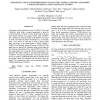Free Online Productivity Tools
i2Speak
i2Symbol
i2OCR
iTex2Img
iWeb2Print
iWeb2Shot
i2Type
iPdf2Split
iPdf2Merge
i2Bopomofo
i2Arabic
i2Style
i2Image
i2PDF
iLatex2Rtf
Sci2ools
IGARSS
2010
2010
Enhanced Cloud algorithm from collocated CALIPSO, CloudSat and MODIS global boundary layer lapse rate studies
Coincident profile information from CALIPSO's lidar and CloudSat's radar offers a unique opportunity to map the vertical structure of clouds over the globe with accuracies never before realized. At Langley NASA, both CALIPSO and CloudSat are collocated with each MODIS 1-km pixel to create a new data set named C3M (Figure 1). A year (July 2006 - June 2007) of C3M data is used to derive global lapse rate maps, as an enhancement to NASA Langley's CERES Cloud Property Retrieval System (CCPRS) [1]. The lapse rates are derived for boundary layer clouds using the the cloud-top temperature from Aqua MODIS level 1 data, skin temperature over ocean and surface temperature over land from the GMAO GEOS-4, and cloud-top height from CALIPSO. The derived global lapse rate maps are used to process a month of CERES-MODIS data to calculate cloud top heights, which are compared with CALIPSO cloud top height. The comparisons shows good agreement between CERES-MODIS and CALIPSO.
| Added | 18 May 2011 |
| Updated | 18 May 2011 |
| Type | Journal |
| Year | 2010 |
| Where | IGARSS |
| Authors | Sunny Sun-Mack, Patrick Minnis, Seiji Kato, Yan Chen, Yuhong Yi, Sharon Gibson, Pat Heck, Dave Winker, Kirk Ayers |
Comments (0)

